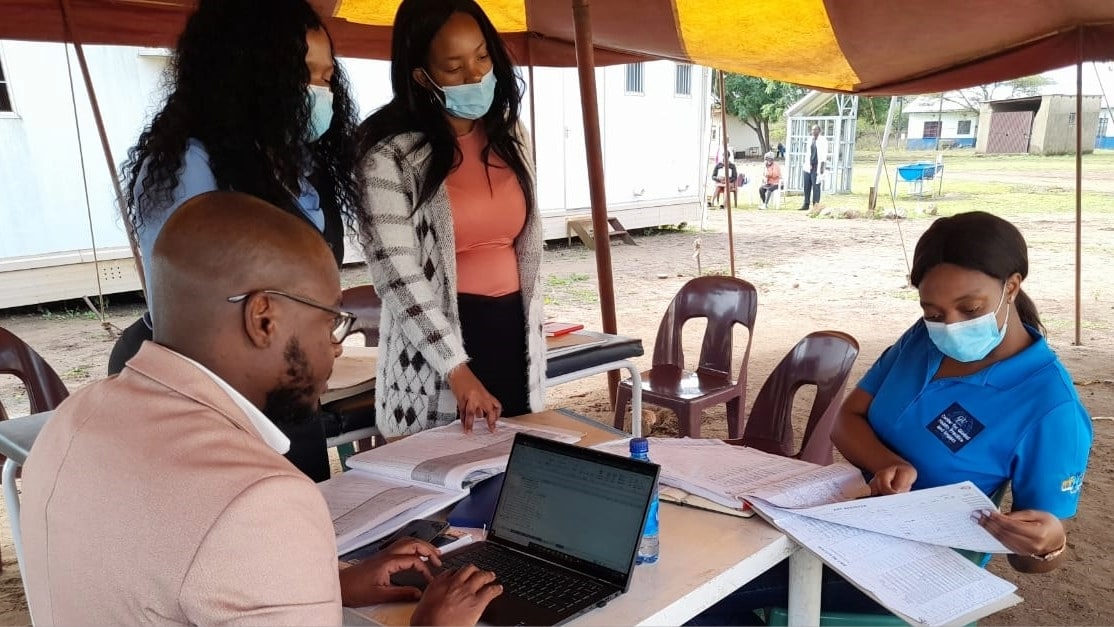At a glance
CDC has been working with the Government of the Kingdom of Eswatini (GoKE) since 2004 and established an office in 2007. CDC collaborates with GoKE and partners to build and strengthen the country’s core public health capabilities. CDC works to address the HIV and tuberculosis (TB) epidemics, strengthen health systems, and enhance global health security. CDC’s work aims to protect the health of Americans and support public health around the world.

Key accomplishments
- Strengthening the collection, use, and dissemination of service delivery, program, and surveillance data.
- Ensuring accurate and reliable diagnostics by facilitating two national reference laboratories to achieve international accreditation.
- Developing health workforce disease detection skills through establishment of the Field Epidemiology Training Program (FETP).
- Leveraging HIV surveillance and laboratory data systems and infrastructure to monitor for and respond to emerging disease threats such as COVID-19, cholera, and monkeypox.
- Supporting the implementation of an automated medication dispensing system to increase access to HIV medication.
- Informing policy recommendations through generation of evidence such as HIV case-based surveillance, HIV drug resistance monitoring, and evaluating new diagnostic modalities for TB.
Global health security

CDC’s global health security investments strengthen public health systems. This work improves Eswatini’s ability to prevent, detect, and respond to public health threats. Investments are being leveraged to support the government in establishing Eswatini’s National Public Health Institute, also known as “Eswatini CDC".
Laboratory strengthening
CDC, through the U.S. President’s Emergency Plan for AIDS Relief (PEPFAR), supports Eswatini’s national laboratory programs to strengthen diagnostic systems for HIV, TB, and other diseases. CDC strengthens connections between health facilities and laboratories in the Eswatini Health Laboratory Service network. CDC supports a robust specimen transport network and laboratory information system for the timely return of results.
CDC also provides technical support for:
- Strategic planning
- Optimizing diagnostic networks
- Assuring laboratory quality standards
- Upskilling medical laboratory professionals
- Establishing a national public health laboratory
These investments have:
- Improved access to HIV viral load monitoring and early infant diagnosis
- Helped introduce new ways to identify advanced HIV disease
- Increased diagnostic options for TB
- Supported the COVID-19 response and other public health responses
Workforce development
CDC, through PEPFAR, supports the collection, use, and dissemination of service delivery and surveillance data to inform program activities and policy recommendations. Examples include:
- HIV case surveillance to monitor for concerning trends in new infections, deaths, and other early warning indicators
- Monitoring for HIV drug resistance
- Evaluating the introduction of computer-aided diagnosis for TB
Surveillance data systems and infrastructure have been leveraged for the country’s COVID-19 and other public health responses through developing data dashboards, situation reports, and port of entry screening procedures.
Through the PEPFAR-supported nursing leadership initiative, CDC supported the Ministry of Health to revamp its nursing leadership curriculum, train over 400 frontline nurses in public health emergency management, and strengthen disease detection capabilities by establishing and implementing FETP.
Continuous quality improvement
CDC works with the Ministry of Health to enhance service quality, reduce HIV and TB transmission, and increase impact. Joint site assessments provide timely performance feedback to healthcare providers and program implementers at the site, regional, and national levels. Data-driven program review meetings inform improvements in service delivery.
HIV and TB
As a key implementer of the U.S. President's Emergency Plan for AIDS Relief (PEPFAR), CDC plays an essential role in the fight against HIV and TB. With unmatched scientific and technical knowledge and long-standing relationships with ministries of health, CDC is uniquely positioned to advance HIV, TB, and other global health security activities that keep Americans safe at home and abroad.
Through PEPFAR, CDC provides critical support to Eswatini's public health infrastructure, improving the country's ability to prevent, detect, and respond to HIV, TB, and other infectious diseases and minimizing their risk from entering the U.S.
- Eswatini Lab Information System
- Eswatini HIV Recent Infection Surveillance system (EHRIS)
- Eswatini | Data (worldbank.org)
- UNAIDS data 2023
- Eswatini Population Based Impact Assessment (SHIMS3) Final Report
- VACS2022 Report. Deputy Prime Minister’s Office (DPMO), Government of the Kingdom of Eswatini. Eswatini Violence Against Children and Youth Survey, 2022 Priority Indicator Report. Mbabane. November 2022
- SHIMS2 Report. Government of the Kingdom of Eswatini. Swaziland HIV Incidence Measurement Survey (SHIMS) 2 2016-2017. Final Report. Mbabane, Government of the Kingdom of Eswatini; 2019. https://phia.icap.columbia.edu/eswatini-final-report/
- World Health Organization Tuberculosis Profile: Eswatini
- TB drug resistance 2018 survey
- Baylor College of Medicine Department of Pediatrics: TB GAPS Project
- World Health Organization

![[thumbnail] (hidden)](/global-health/media/images/2025/11/Eswatini_thumbnail.jpg)